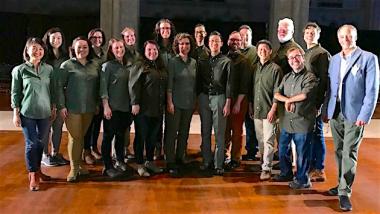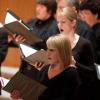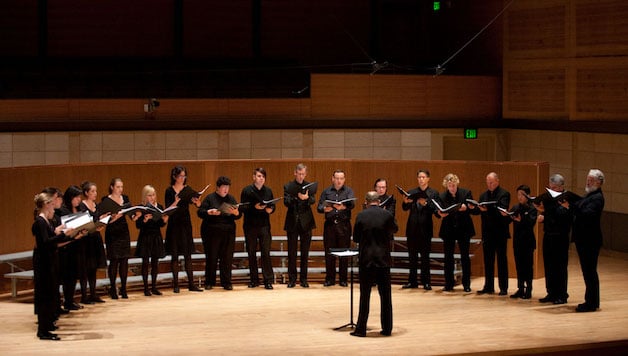
Robert Geary founded the San Francisco Chamber Singers in 1979 with the goal of discovering, creating, and performing new, unaccompanied vocal music. The group (which has varied in size from 17 to 30 singers depending on performance requirements) started focusing entirely on contemporary music during the 2003–2004 season. Because the name of the ensemble implied looking back at older repertoire instead of forward to new works, SFCS changed its name to Volti, a reference to the Italian musical term “volti subito” meaning “turn [the page] quickly, look ahead!” The tagline “singing without a net” was added at about the same time to underscore Volti’s new focus.
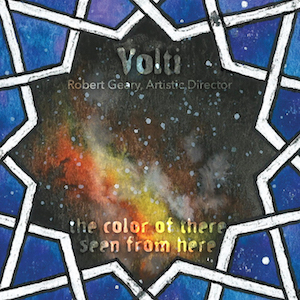 Volti’s mission, as stated by Artistic Director Robert Geary, “is to foster and showcase contemporary American music and composers, and to introduce contemporary vocal music from around the world to local audiences.” The Color of There Seen from Here (Innova, distributed by Naxos) does exactly that and is being released to celebrate Volti’s 40th season. Four of the five works are world premieres written specifically for Volti, all five are premiere recordings, and all of these American composers have created diverse sound worlds that will stretch your listening skills and ways you think about music. The music is adventurous, surprising, inventive, and best of all, enjoyable. All of the selections are technically difficult, often using extended vocal techniques, but performed flawlessly without a note out of place or voice out of tune, and there isn’t a weak piece among them.
Volti’s mission, as stated by Artistic Director Robert Geary, “is to foster and showcase contemporary American music and composers, and to introduce contemporary vocal music from around the world to local audiences.” The Color of There Seen from Here (Innova, distributed by Naxos) does exactly that and is being released to celebrate Volti’s 40th season. Four of the five works are world premieres written specifically for Volti, all five are premiere recordings, and all of these American composers have created diverse sound worlds that will stretch your listening skills and ways you think about music. The music is adventurous, surprising, inventive, and best of all, enjoyable. All of the selections are technically difficult, often using extended vocal techniques, but performed flawlessly without a note out of place or voice out of tune, and there isn’t a weak piece among them.
Forrest Pierce’s Gratitude Sutra is the most traditional work on the disc, melodic with recognizable chord transitions and resolutions. While it incorporates a few dissonances and unusual harmonic changes, it has a familiar feeling and successfully reflects the “words of simple gratitude” of the “Prayer for the Great Family” from Turtle Island by Gary Snyder. It’s an engaging way to start the program.
Tonia Ko’s From Ivory Depths sets fragments of text from Virginia Woolf’s writings and is a highlight. This composition introduces more dissonances and a wider variety of vocal techniques than are found in Gratitude Sutra. The second movement, “Tuesday,” creates colorful, textured soundscapes with extended techniques. It engages your mind and ears and invites you to listen more deeply.
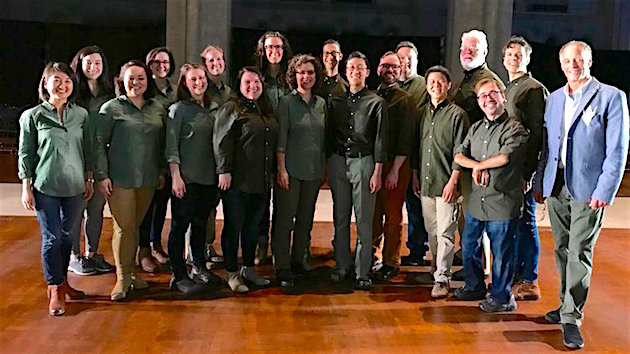
Philippine composer Robin Estrada’s Cæli enarrant combines Western forms with Southeast Asian musical styles. It’s intended to reflect the world’s current conflict-filled climate and does this in three parts: the opening section, based on a traditional Asian call-and-response style of prayer, a second part where interlocking melodies create a sense of organized chaos, and a conclusion with a meditative feel. Estrada’s contribution, one of the more energetic and percussive pieces on the program, uses both gamelan-influenced rhythms and reflective moments to inspire people to treat others as they themselves would want to be treated.
A variety of effects appear in All Night by Mark Winges, which is based on the poetry of Gustaf Sobin. Winges describes the poet’s language as “rich, dense, and sparse, all at the same time…” just like Winges’s musical language. Chromaticism, driving rhythms, and various word and vocal sounds explore the poems’ underlying moods. This is complex and intriguing music that’s also conventional and spacious: you’re likely to return to it many times.

Unlike the other pieces here, Lithuanian composer Žibuoklė Martinaitytė’s The Blue of Distance is based on speech sounds, mostly humming, and sung open vowels instead of texts. It’s soft and atmospheric, harmonically slow-moving as it washes over you, except for waves of sound that envelope the listener from time to time. The Blue of Distance, inspired by Rebecca Solnit’s book A Field Guide to Getting Lost (also the source for the title of the recording), brings the CD full circle.
The booklet is filled with helpful notes and good information about the composers. (Next time Volti makes a recording some samples of what the scores look like should be included.) Sound quality is very good considering the pieces were recorded over a period of five years at two different places (in a studio and a church). The width, depth, and blend are fine but it’s difficult to judge the size of the group or where singers are located. Complete texts are printed, especially valuable since words are often manipulated by the composers or sometimes lost in the reverberation.
Volti has been a Bay Area treasure for 40 years and “singing without a net” all along. Volti is still singing without a net and doing it oh, so well.

